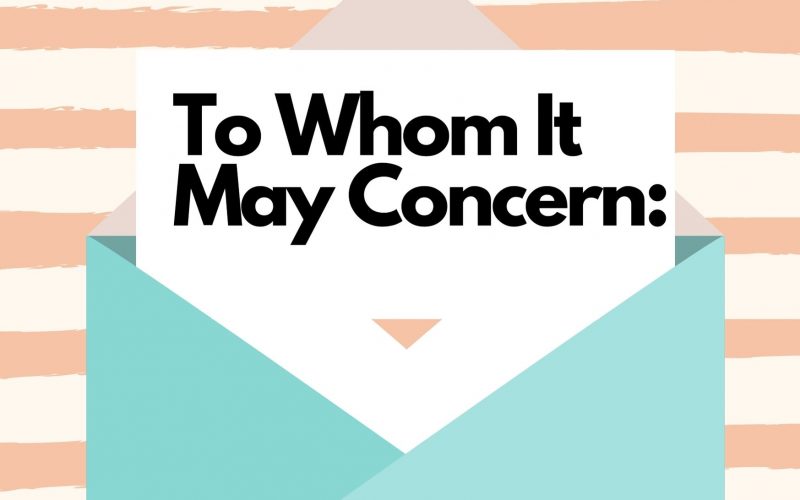It used to be customary to begin business correspondence with the salutation To Whom It May Concern, back when almost everyone had access to the Internet in their hands. However, the times have changed. We’ll look at when to use or when not to use To Whom It May Concern, consider other alternatives, capitalization, and discuss the one type of correspondence where this greeting is still appropriate.
To Whom It May Concern
As a salutation, the phrase “To Whom It May Concern” is commonly used at the start of a letter or email. It’s typically used to communicate with someone whose name you don’t know but want to include in the message. As previously stated, this is now considered obsolete.
When a company announced a job opening in the past, all you have was the company’s name and a brief description of the position you were applying for.
It was unusual for them to mention the hiring manager’s name. Because there was no easy way for you to obtain this knowledge, people would address letters to whomever the letters were addressed to, hence the expression.
Having information on any company, on the other hand, is now as simple as pressing a button. The majority of organizations and enterprises include a section dedicated to their employees. You will be able to find all of the information you require here. Though using the statement is commonplace, some hiring supervisors may interpret it as laziness on the part of the candidate.
Overview
When writing a letter or an email, people tend to start by greeting the recipient. Your greeting will set the tone for the entire message and determine whether it is informal, formal, or neutral.
Suppose you are thinking about reaching out to a hiring manager at a major company. In that case, you will always want to keep things as professional as possible and use a proper greeting. “To Whom It May Concern” is one of the most traditional ways of addressing someone you might not know, but it is also archaic.
Ever since the turn of the century, today’s technological advances have made it easier for people to access information about one another. This makes it even more convenient for people to know who they will be addressed when writing a letter or an email.
Taking the time and searching for the name of the person you are trying to contact can go a long way in the hiring process. It shows initiative and demonstrates that you are willing to put in some work and go the extra mile.
Here you will learn the meaning behind the phrase “To Whom It May Concern,” when you should use it and when you should avoid it, and some alternatives you can use in its place.
To Whom It May Concern’ capitalization
To Whom It May Concern’ is a common salutation for letters and emails that are more formal in nature. This phrase is typically used in business correspondence rather than for personal correspondence. While this salutation is formal, there are particular times when you should and should not use it. Here we explore the type of correspondence when this phrase is acceptable, ‘To Whom It May Concern’ capitalization guidelines, when to use this salutation, and steps to take before using ‘To Whom It May Concern.’
It is almost always appropriate to capitalize all of the first letters of each word in ‘To Whom It May Concern.’ As a general rule, think of this phrase as a stand-in for the individual whose name you’re writing. The phrase “To Whom It May Concern” should be capitalized in the same way that the initial letter of a person’s name is capitalized. After ‘To Whom It May Concern,’ add a colon or a comma, a space, and then jump right into the letter’s body.
When to Use To Whom It May Concern
“Who is the intended recipient of this message?” ask yourself before sending each piece of correspondence.
If the answer is “Anyone,” the phrase “To Whom It May Concern” should suffice. If, on the other hand, your end reader has a specific function or title, keep looking for their name. It’s difficult to determine when to say “To Whom It May Concern,” so here are a few examples of when it’s typically acceptable:
#1. Reaching out to a large company or new department
If you’re contacting a huge company with a complicated organizational structure and aren’t sure who to contact, you can use the company’s web site’s message form or send an email to a general address like “[email protected].” “To Whom It May Concern” may be suitable in this scenario. When using this method, we recommend including a request for the appropriate point of contact in the body of your message.
Example:
To Whom It May Concern:
I saw your company announced the opening of two new coworking spaces on the east coast. I work with Level, a sustainable office furniture company in the Boston area.
We are coming out with a new line of pieces that coincide with the opening of your new space. I’d love to contact the team member in charge of furnishing your locations to discuss the possibility of working together.
Regards,
Joyce
#2. Recommendations/reference checks
If you’re offering a reference or recommendation for a former coworker or employee, the request may arrive through an automated system with no information about the hiring manager.
They don’t expect you to do any investigation into them or their business; all they want is your opinion on the applicant they’re about to recruit. “To Whom It May Concern” might be a good way to address your audience at this point.
Example:
To Whom It May Concern:
Dwight was an excellent employee during his three years at Dunder Mifflin.
He took his work very seriously, volunteered for projects outside his regular duties (i.e., volunteer floor fire warden and safety officer), and was our top-performing salesperson all three years. I would highly recommend him for this position.
Regards,
Peace
#3. Company complaints
Making a formal complaint to a business? You probably don’t care if your complaint reaches an administrator, a customer service representative, or the CEO; all you want is for it to be acknowledged and addressed.
Example:
To Whom It May Concern:
I was extremely disappointed the cat poster I ordered only has three jazz-playing cats instead of the four depicted on your website. I would like a full refund and the correct poster as soon as possible.
Thank you,
Chisom
#4. Introductions
If you’re introducing yourself to someone you’ve never met, “To Whom It May Concern” may be suitable. If you got a request for a quote or information about your company from a generic company inbox or feedback form, for example, you may address your response “To Whom It May Concern.” Simply include a request for their name in your message.
Example:
To Whom It May Concern:
I received your request for a price quote on 50 reams of paper from Dunder Mifflin. I’ve attached the quote to this email and would be happy to answer any questions you have.
Also, I’d love to know your name and a little more about your business!
Kind Regards,
Emma
#5. Prospecting
This is satisfactory, but not ideal. If you’re a salesperson doing outreach, it’s your responsibility to take the time and do the research to know who you’re calling.
Ideally, you should first establish a relationship with them via LinkedIn or Twitter, or by contacting them through a mutual acquaintance. If you can’t discover their personal information anywhere else, try “To Whom It May Concern,” but don’t expect a lot of responses.
Example:
To Whom It May Concern:
I noticed your company recently parted ways with its paper supplier. I work with Dunder Mifflin, a local Scranton paper supplier, and would like to speak with the person in charge of paper orders at your company.
We pride ourselves on personalized customer service and fast delivery, and I’d love to see if we’re the right fit for you.
Best,
Favour
How To Write To Whom It May Concern
If you’re using a formal greeting like “To Whom It May Concern,” be sure you style it properly. The following is an example of how to write “To Whom It May Concern:”
- Capitalize the first letter of each word
- Always use “Whom” instead of “Who” or “Whomever” (In the case of “To Whom It May Concern,” “Whom” is the object of a verb or preposition and is appropriate to use in this context)
- Use a colon after “To Whom It May Concern” rather than a comma
- Add a double space before beginning the body of your message
If you use “To Whom It May Concern,” as we’ve already established, you’re probably approaching a business formal dialogue. Allowing bad formatting to distort your first impression is not a good idea. These pointers should always put you in the best position to succeed.
What is Another Way to Say to Whom it May Concern?
- Dear Sir or Madam
Dear Sir or Madam, This is a greeting that is quite similar to the one that was just mentioned, but it is used in situations in which you have no idea who the person is that you are addressing. It is somewhat analogous to “to whom it may concern,” but it makes an effort to be a little bit more direct.
Is it Still Correct to Use To Whom It May Concern?
The salutation “To Whom It May Concern” is considered archaic and should not be used, particularly in cover letters for job applications. It was the usual practice in the past to address someone with the salutation “Dear Sir or Madam,” but nowadays many people find such expression archaic and unprofessional. Additionally, it does not include everyone.
How Do You Start a Letter Without Saying To Whom it May Concern?
The greeting “Dear [job title]” is considered to be the most appropriate for a cover letter. If you address your cover letter to “Dear hiring manager,” it will get to its intended recipient directly and without any delay, and it will demonstrate your interest in the position almost as effectively as if you were to use the hiring manager’s actual name.
How Do You Start a Formal Letter?
The greeting “Dear” is used at the beginning of the majority of formal letters, which is followed by the recipient’s name. You have the option of using either your first name and last name, or your title and last name. You are required to write “Dear Sir or Madam” if you are unsure of the identity of the person to whom you are addressing the letter.
What is a Good Greeting for Professional Email?
“Dear (name)” is an appropriate greeting for all formal emails; nevertheless, due to its slightly archaic tone, it is not the best choice for informal letters. Greetings is a typical and courteous way to begin an email that is being sent to multiple recipients at once, or to a single recipient when you are unsure of how to spell their name.
When Not To Use To Whom It May Concern
Avoid using the phrase “To Whom It May Concern” whenever possible. It’s mostly antiquated, stuffy, and sluggish. With today’s internet connection, finding the name and even email address of the individual with whom we wish to communicate is rather simple.
As a result, “To Whom It May Concern” can imply a lack of effort in correspondence, which doesn’t bode well for the rest of your commercial relationship.
Here are a few tips for finding almost anyone’s name:
#1. Ask your HR rep or recruiter
If you’re writing a cover letter or email to a hiring manager, ask your recruiter or HR rep for the correct name.
#2. Visit the company’s LinkedIn profile
You’ll see a hyperlinked prompt at the top of their page that says, “See all [number of employees] on Linkedin.” To get a list of all employees, click that prompt. You should be able to browse through the list until you come across the person, role, or title you’re looking for.
#3. Visit the company’s “About Us” page
On their “About Us” or “Team” page, smaller businesses may identify all employees and their titles. At the absolute least, thus there will be a general business inbox where you may ask for the name of the individual you’re attempting to contact.
#4. Pick up the phone
Ask the receptionist or administrator at the company where your prospect works for that person’s name, contact information, or advice on how to reach them.
Finding the name of the person you’re contacting may take a few more minutes, but it’s crucial. Before using “To Whom It May Concern,” show your email recipient that their name matters to you by looking it up.
If you chance to come across your contact’s name while conducting your own research, you should tell them how you discovered their information.
Example:
Hi Kayla,
We have some mutual connections on LinkedIn, also I saw your recent post requesting introductions to sales automation specialists.
This is an area of expertise for my organization. Would you like to schedule an introductory phone call? I would be happy to answer any questions you have.
Regards,
Dan
Alternatives to ‘To Whom It May Concern
The following are several alternative salutations you can use in place of ‘To Whom It May Concern:
- Dear Recruiter
- Dear Hiring Manager
- Human Resources/HR Manager
- Dear Hiring Committee
- Dear [Title of Department]
- Hello
- Dear Personnel Manager
- Dear Recruiting Manager
- Greetings
- Hi there
- Sir or Madam Recruiting Department
- Dear [Company Name] Recruiter
- Dear [Title of Department] Director
- Good Morning
- Good Evening
- Hi All
What is a Proper Professional Greeting?
When writing formal letters, you should use a greeting that is more professional than simply saying “Hi (first name),” for example. When writing a formal letter, the greeting “Dear (first name) (last name)” is the most appropriate way to begin the letter. It conveys respect as well as courtesy and professionalism all at the same time. If you know the recipient’s title, you can use it in place of ‘Dear’ in the greeting.
Which Greeting is Best for a Formal Business?
In English, instead of saying “hi,” you should use the more formal “Good morning” or “Good afternoon,” and don’t forget to thank everyone who came for their attendance. The next step, if you are in charge of leading the meeting, is to make an announcement that the meeting has begun. Take this as an example: “Good morning.
What is the Most Polite Greeting of All?
Formal pleasantries, such as “hello,” as well as time-related greetings, such as “good morning” or “good evening,” are often considered to be the most respectful. Add the listener’s official title at the end of the greeting to make it even more courteous. For example, you could say “hello, Mr. or Mrs.” or even “hi, sir or ma’am.”
FAQ
Is it rude to write to whom it may concern?
To whom it may concern” works well in cases where you don’t know the name of your recipient(s) and want to come across as respectful, but in other contexts, it is not the most appropriate choice; and in some moments, it’s not an appropriate choice at all.
How do you start a letter to someone you don't know?
If you do not know the name of the person you are writing to, begin with Dear Sir or Dear Sir or Madam or Dear Madam and end your letter with Yours faithfully, followed by your full name and designation.
How do you start a letter to an unknown person?
If the name of the intended recipient is unknown, acceptable salutations are Dear Sir or Madam (If the gender of the reader is unknown).






